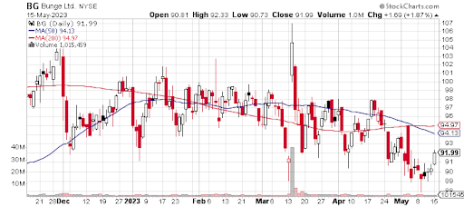The first ETF (as we know them today) was the SPDR S&P 500 ETF (SPY) and it launched with just $6 million in assets under management (AUM), with over $1 million in trading volume on the first day all the way back in 1993.
Now, the SPY has roughly $380 billion in assets, which represents about 20% of the total value of domestic large-cap ETFs ($1.9 trillion total). And that’s just a fraction of the $6.5 trillion of investments in domestic ETFs as of the end of 2022.
In other words, ETFs have rapidly become big business with billions of dollars to throw around and the ability to move share prices significantly when they start accumulating shares.
Now, with a discretionary or actively managed fund, your guess is as good as mine as to where a fund like the Ark Innovation Fund (ARKK) is going to make its next multi-billion-dollar investment.
However, there is one area where fund managers are compelled to make specific investments: the S&P 500 rebalance.
We’re all familiar with the S&P 500 index, which represents the 500 largest listed U.S. stocks ($12.7 billion market cap is the current cut-off, firms must also have a history of positive earnings and must meet certain liquidity and size thresholds), but, as you can probably guess, market movement can push the smallest constituents above or below that threshold on a daily basis; the 501st largest company can easily become the 499th largest based on a single day’s trading.
Compelling fund managers to rebalance every day to ensure their passive S&P 500 fund matches the index is untenable, so the index has a specific set of criteria for rebalancing, which you can see here. Without delving too deeply into weightings or exceptions, the basic version is that the S&P 500 rebalances “quarterly after the close of business on the third Friday of March, June, September, and December.”
S&P Dow Jones publishes announcements related to rebalancing here, and the latest quarterly S&P 500 rebalance saw Fair Isaac (FICO) replace Lumen (LUMN) in the large-cap index, while Lumen replaced Bed Bath & Beyond (BBBY) in the small-cap index.
In addition to the quarterly S&P 500 rebalance, the indexer will replace companies as needed should they go bankrupt or cease trading (or fail to meet other criteria, which you can see in the link above). This has been particularly relevant of late as the failures of three regional banks (First Republic, Silicon Valley Bank, and Signature Bank) prompted their replacement in the S&P 500 by Axon Enterprise (AXON), Insulet (PODD), and Bunge (BG), respectively.
To summarize, passive fund managers oversee trillions of dollars; the S&P Dow Jones Indices tell them what stock they have to buy; that information is then made available to the investing public before the fund managers reallocate.
That seems like it should be an automatic recipe for success. And, for a time, it was. For years the bump in stocks being added to indexes was tangible and significant enough to earn the nickname “the index effect.” From 1995 to 1999 stocks added to the S&P 500 generated 8.3% in excess returns from the announcement date to the addition date. From 2000 to 2010, that number declined to 3.6%. From 2011 to 2021, the effect seems to have disappeared according to this analysis by S&P.
The S&P analysis attributes the decline of the index effect to more liquidity and increased indexing to mid- and small-cap indexes. (More money in mid-cap funds in the last decade means that the constituents that “graduate” to the large-cap S&P 500 already have significant fund investment.)
Although excess returns have seemingly evaporated, announcements that companies are moving up to the big leagues can still have a big impact on share prices simply because of the additional attention. Let’s take a closer look at Fair Isaac and Bunge to see how they’ve performed since their respective additions to see if it might still make sense to buy the S&P 500 rebalance.
| Company | Date Of Announcement | Performance Since |
| Fair Isaac (FICO) | 3/3/23 | 7.20% |
| Bunge (BG) | 3/13/23 | 0.70% |
Fair Isaac was announced as part of the regular quarterly rebalance and is up 7.2% since the announcement date while the S&P 500 is up 2.2% in the same period. Bunge, on the other hand, was an unscheduled replacement that’s up 0.7% since its announcement while the S&P is up 7.3% during that time.
But, take a look at the chart of Bunge below:
Bunge gapped up significantly, closing more than 14% higher on the first day of trading after the announcement. And it just as quickly gave back those gains, which evaporated before the end of the same week.
Why?
Let’s look under the hood a little. SPY, with its $380 billion AUM, has allocated 0.04% of that total to Bunge (makes sense intuitively, it’s not as if Bunge is jumping from outside the S&P 500 to a top 100 company by market cap; it’s in the 400s so the allocation is proportionally small). To fully satisfy SPY’s allocation to BG, the fund needed to acquire roughly $150 million of the stock, which is less than a day’s average trading volume.
In essence, the “noise” of the announcement drastically outweighed the impact of the fund buying, hence the gap up and backfill lower. Plus, any mid-cap funds holding BG are obligated to sell shares since it’s no longer a mid-cap company.
If you’re holding shares in a company that gets added to the large-cap funds as a result of the S&P 500 rebalance there may be an incremental benefit from additional fund buying, but, as BG and S&P research show, you can no longer rely on the index effect and could easily get burned chasing a stock that pops.
Bottom line: Like flip phones and AOL, the index effect may have been a meaningful trend in the ‘90s and even into the early 2000s but is now essentially extinct.


